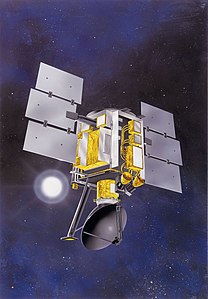QuikSCAT
| QuikSCAT | |
|---|---|

|
|
| Type: | Research satellite |
| Country: |
|
| Operator: |
|
| COSPAR-ID : | 1999-034A |
| Mission dates | |
| Begin: | June 20, 1999, 02:15 UTC |
| Starting place: | Vandenberg AFB SLC-4W |
| Launcher: | Titan II |
| Status: | inactive |
| Orbit data | |
| Rotation time : | 100.93 min |
| Orbit inclination : | 98.6 ° |
| Apogee height : | 815 km |
| Perigee height : | 281 km |
| Eccentricity : | 0.00014 |
QuikSCAT (abbreviation of Qui c k Scat terometer ) is an observation satellite of NASA , whose task it was for the NOAA information on the wind speed and direction over the oceans to collect. The mission was launched at short notice because the NSCAT instrument on board the Japanese ADEOS-I satellite had not transmitted any data since June 1997 due to a power failure . QuikSCAT was launched into sun-synchronous Earth orbit on June 20, 1999 on a Titan II from Vandenberg Air Force Base .
QuikSCAT was part of the Earth Observing System , a long-term research program run by NASA.
Although designed to last for two years, QuikSCAT operated for over ten years until the mechanism for rotating the scatterometer antenna failed on November 23, 2009. This reduced the swath width to 30 km so that large-area measurements were no longer possible. Nevertheless, QuikSCAT remained in use and served as a standard for calibrating new satellites. On October 2, 2018, the satellite was finally switched off.
See also
Web links
- Homepage of QuikSCAT satellites (English)
Individual evidence
- ↑ Spaceflight Now: Wind sensor failure ends long-lived satellite mission
- ^ NASA: After Two Long Careers, QuikSCAT Rings Down the Curtain. October 12, 2018, accessed October 16, 2018 .
